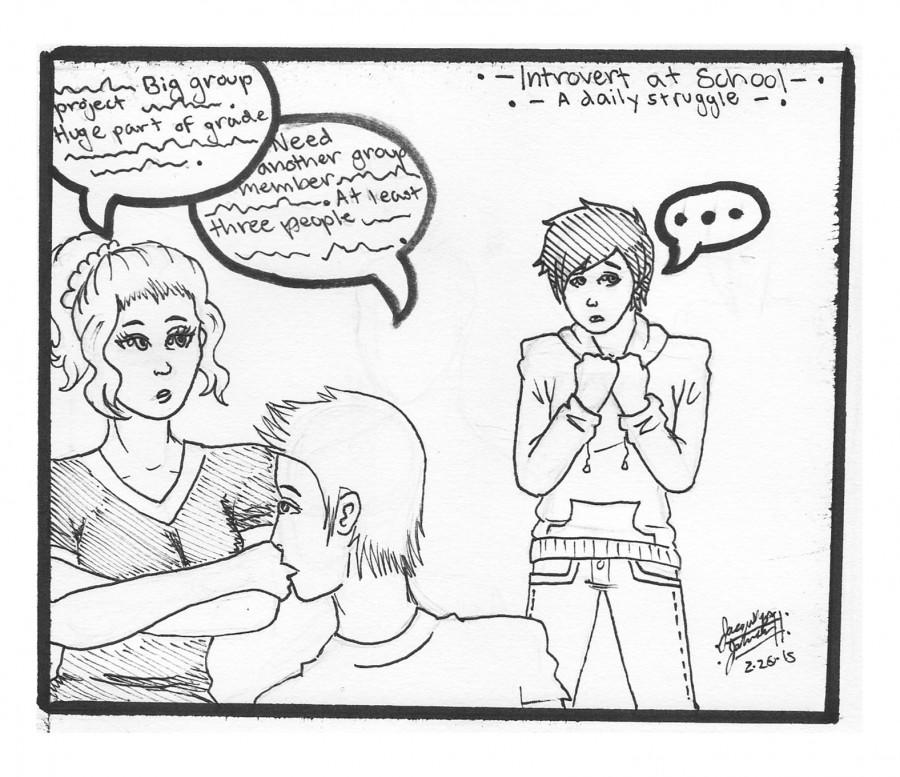Introverts at a disadvantage in school
Does school cater to one kind of personality at the expense of the other?
February 27, 2015
From a young age, society imposes on us that bolder is better, more gregarious people are happier, and outgoing people make better leaders.
Schools often comply with these ideals and are built to fit our culture: a society that epitomizes the charismatic individual and favors the man of action over the man of contemplation. Simply, most of western society is currently organized for extroverts.
Many classrooms are designed where desks are arranged in pods, class participation is highly emphasized, and group work is constantly used. In addition, a vast majority of research has concluded that most teachers report an ideal student as more extroverted.
Introversion versus extroversion refers to the amount of stimulation one prefers; introverts prefer lower levels of stimulation whereas extroverts crave more stimulation. Introverts oftentime feel most energized when they are by themselves, while extroverts recharge by being around others.
In creating classrooms to fit the extroverted student, we are missing a fundamental and crucial aspect to education: trying to maximize the success for all. To improve success, it is necessary for everyone to be exposed to the amount of stimulation that is right for them.
With constant group work and appraisal of participation, many students often try to prove they are more extroverted than they truly are, as they have been conditioned to believe that behaving assertively will get them farther socially and academically.
“We turn extroverts into an oppressive standard, which we turn into a bias we feel we must conform,” wrote Susan Cain, author of the novel “Quiet: The Power of Introverts in a World That Can’t Stop Talking.” She added, “I believe that introversion and extroversion are as profound part of our identities as our race and gender.”
If introversion and extroversion are so important in our being, why are our educational systems set up to cater to a particular personality?
Many educators believe creativity and productivity is stimulated from collaborative settings and sociable places. Students who prefer to work by themselves are sometimes seen as outliers, which makes them feel guilty about wanting to work alone.
However, group settings are not the only way to produce success. Solitude is often a crucial aspect to creativity and innovation. Cain said, “Solitude matters. For some people it is the only air that they breathe.”
Eleanor Roosevelt, Rosa Parks, Gandhi, and Steve Wozniak were all introverts. Processing their ideas internally enabled them to think creatively and profoundly impact society. This shows the significance of allowing people to work individually.
This is not to discredit the power of working collaboratively. Working with others is a very effective way to learn and come to a consensus, plus it is a crucial skill for students. However, everyone should have the opportunity to work individually before coming together to collaborate and discuss ideas.
Culturally–specifically in education systems–we need a better balance between introverted and extroverted needs. Instead of constantly praising the extroverted individual who thrives in group settings, schools should also commend the student who is able to process information individually.
Educators must recognize that introverts and extroverts work differently. Generally, introverts complete assignments slowly and deliberately, and they’re better at focusing their attention on one task. Extroverts tend to tackle assignments quickly and sometimes make rash decisions, plus they are more comfortable with risk taking and multitasking.
Nearly a half to a third of the population are introverts. This means that one out of every two or three people thrive when they are allowed to run free with their ideas without distraction from bolder opinions and stronger voices.
“Groups famously follow the opinions of the most dominant or charismatic person in the room even though there is zero correlation between being the best talker and having the best ideas,” said Cain. Many introverted students would prefer to brainstorm individually without feeling the need to bolster an outgoing personality in order to voice their opinion.
It is crucial that we identify and examine the core characteristics that make up students. In order to improve students’ learning, teachers must be able to understand various personality types and learning styles. Not everyone thrives in group settings, has the loudest voice, the strongest opinion, or is energized by social interaction.
It may seem a dooming task to change the way we educate students in order to equalize abilities for all kids, but it is a necessary one. Schools should provide every student with the opportunity to thrive.











